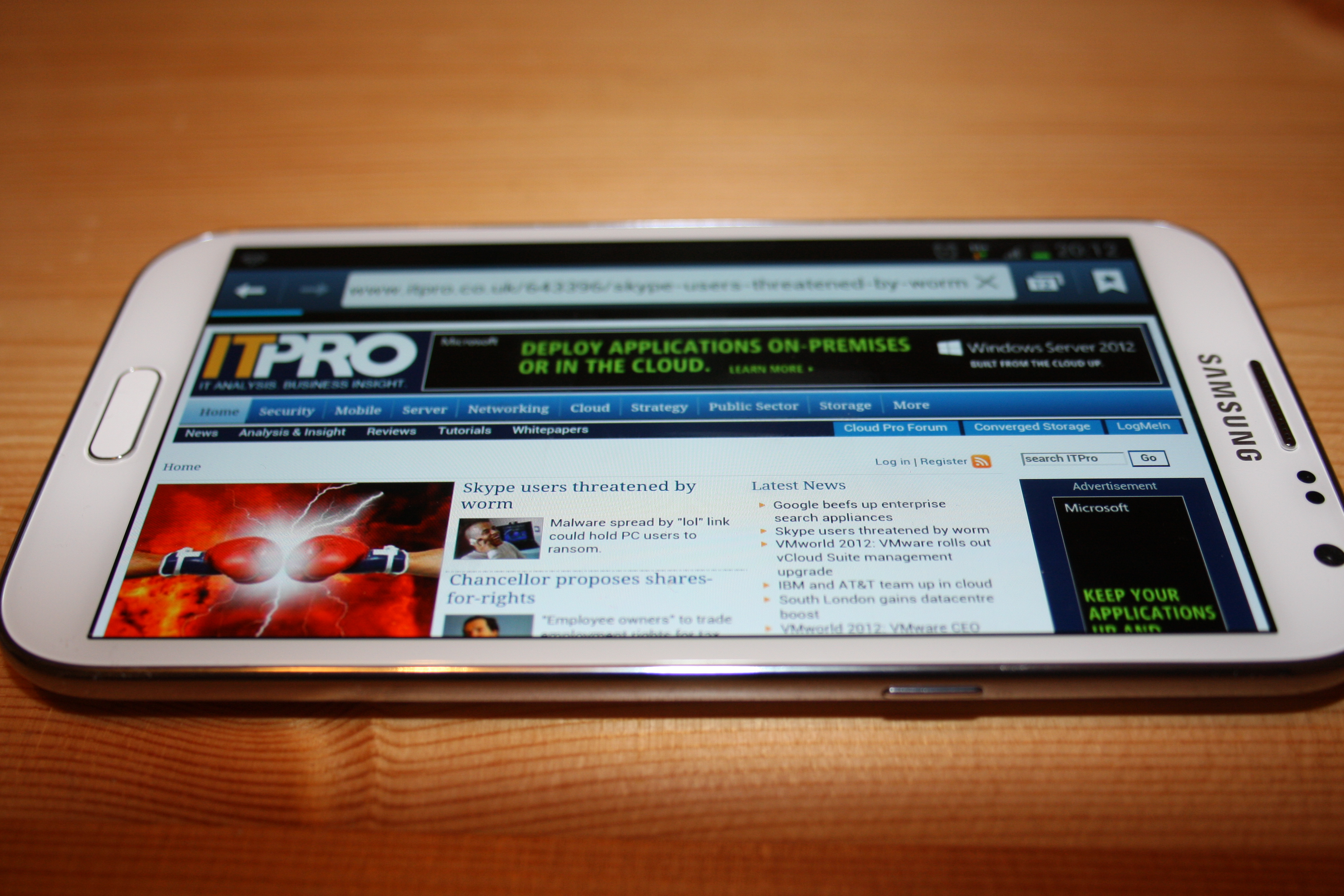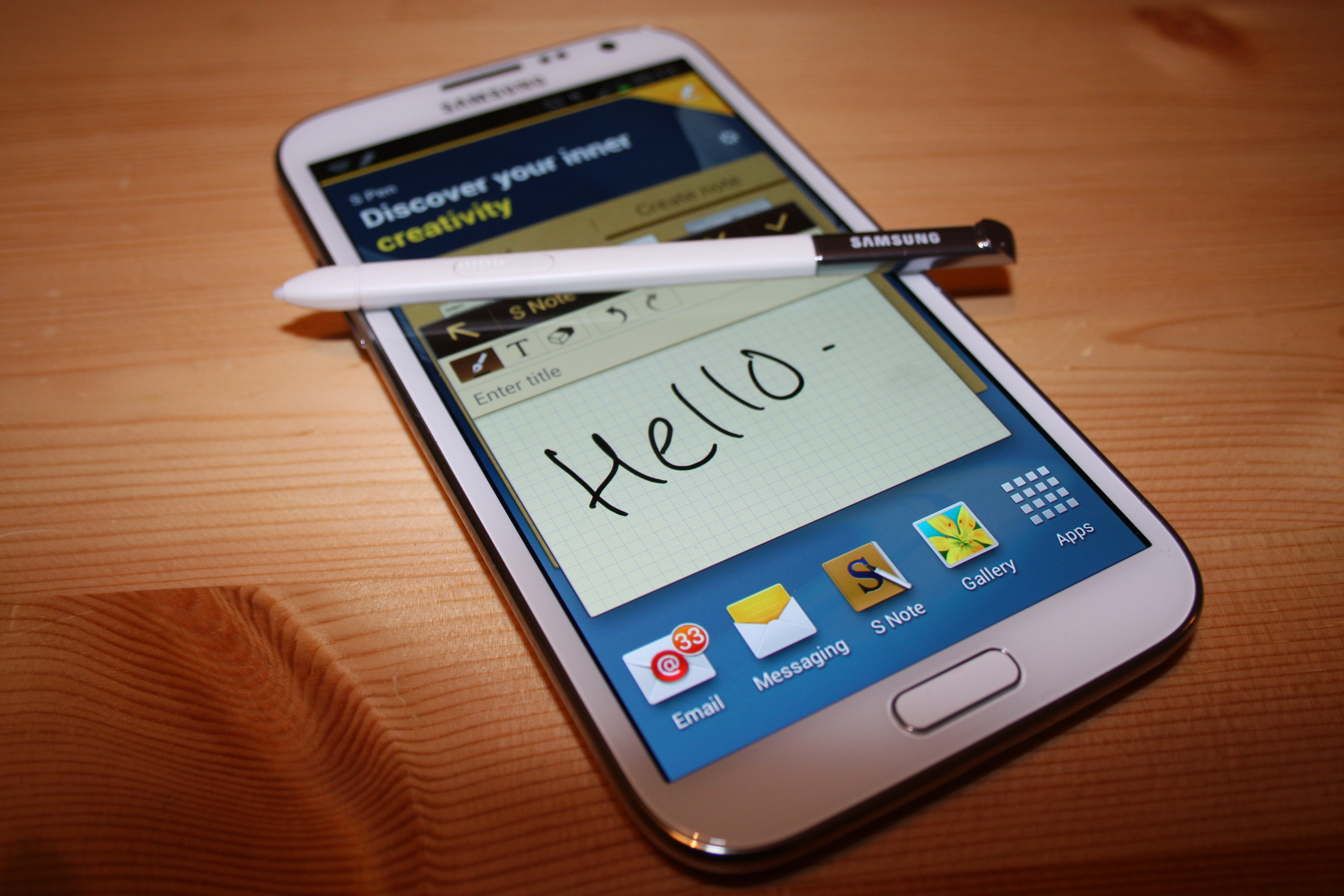Samsung Galaxy Note 2 review
The second generation hybrid device ships with a mammoth 5.5in display, Android Jelly Bean and packs a great battery life, making it an ideal business productivity tool.
The Samsung Galaxy Note 2 is a huge improvement on the Samsung Galaxy Note and the best large format smartphone we’ve seen. With all the S Pen functions, Android Jelly Bean, nippy processor and of course, that largebattery, it’s the first phablet we’ve seen that works as such. With a couple more refinements, such as better use of that large screen, Samsung could have the format perfected, just like Apple has the tablet perfected in the form of the iPad.

Samsung aims to attract business users to Android with the smarpthone/tablet hybrid Galaxy Note 2. The firm has made enhancements to the S Pen features, added a huge battery and offers Android 4.1 Jelly Bean out-of-the-box.
There's much to like about the Note 2, but the sheer size of the device (5.5ins) means that it will not be suitable for everyone.
Upgrades
One of the first things you'll notice about the Note 2 is the striking similarity to Samsung's flagship Galaxy S3 handset. The Korean manufacturer has packed many of the same features such as the Exynos quad core processor (albeit clocked to a slightly faster 1.6GHz) along with Samsung's S Voice and Smart Stay tech. The latter detects the movements of your eyes to ensure the screen's brightness is correctly adjusted.
The 1.6GHz quad core processor provides a smooth experience, coupled with Android Jelly Bean's Butter UI. The chipset is able to handle multiple applications running in tandem without a hitch. We found the device ran for two days with 10 apps open without any problems.
The main difference between the Note 2 and any other Android smartphone is the screen size. Samsung has included a mammoth 5.5in, which is bigger than the original Note (5.3in) and the S3 (4.8in).
On the plus side, the 1280 x 720 resolution of the dislay helps to render a superb picture and the size makes the handset great for viewing web pages, documents and videos. However, one-handed use is impossible even if you've got giant hands. You'll also want to use headphones to make calls and avoid the inevitable embarrassment when you hold it up to your ear.

The 5.5in screen on the Note 2 makes it ideal for content consumption
Battery
There's just one word to describe the battery life on the Note 2: phenomenal.
We used the Note for 16 hours before it beeped to say the battery was low and even then the bar was still green.
In our intensive 12 hours test where we synced up email and social networking sites, carried out an hour of phone calls and even watching an hour-long documentary on the commute home, there was still 30 per cent of battery remaining.
The great battery life is due to the large 3100mAh pack, and its removable for you can carry round a spare in the unlikely event you run out of power.
S-Pen
One of the key differentiates is the inclusion of the S Pen stylus. As soon as you remove the S Pen from its holder, the pop up note screen will appear as a small box and you can start writing notes straight away. Just like all the other pop up functions (browser and player) on the Samsung Galaxy Note, you can expand them to full screen if you want. We highly recommend this when using the pop up note function to give you maximum writing area.
We'd recommend you do it will all the pop up items, because although the screen is big, we can't see any point of using only a section to watch media, browse the internet or write notes with the S Pen, unless you're using another app in the background.

The S Pen is unique to the Note 2, and will come in useful for editing content
Page Buddy is a feature specific to the Galaxy Note 2 that brings up hidden functionality when you carry out a certain process. When you take the S Pen out of its holder, for example, an S Note panel will pop up, allowing you to start writing a note right from the homescreen. When the S Pen is in place, that panel displays as blank. You can turn this function on or off though and choose to have these hidden panels on display at all times. It just depends on how much you want on your homescreen.
With S Pen handwriting recognition you may find yourself using the space key rather more often than you wished for. Because the handwriting pad is only a certain size, only a couple of words will fit on it. After a few seconds of writing a couple of words, they will disappear, clearing space for you to scribe the next words. However, whenever the words clear, you'll have to tap the space key otherwise the sentence will all merge together.
Tapping the space bar isn't a huge chore, but it does ruin the flow of writing. We also found that unless every letter is exactly the same size, the recognition will wrongly detect a capital letter. Although we enjoyed the novelty of handwriting recognition, we preferred to use that large keyboard unless you have incredibly neat handwriting.
The screen will detect the pen is close and responds to every stroke, however light they may be. This is refreshing in comparison to older stylus/touchscreen combinations where you had to press hard to garner a response. The only issue we found was that the S Pen is only effective when you're using the tip of the pen. If you angle more than 45 degrees, the screen will struggle to pick up contact.
Setting up email is easy on Android. One warning though: SMS sync is enabled as default, so all your texts will automatically be sent to your exchange email account. This has the potential to be annoying.
Get the ITPro daily newsletter
Sign up today and you will receive a free copy of our Future Focus 2025 report - the leading guidance on AI, cybersecurity and other IT challenges as per 700+ senior executives

Clare is the founder of Blue Cactus Digital, a digital marketing company that helps ethical and sustainability-focused businesses grow their customer base.
Prior to becoming a marketer, Clare was a journalist, working at a range of mobile device-focused outlets including Know Your Mobile before moving into freelance life.
As a freelance writer, she drew on her expertise in mobility to write features and guides for ITPro, as well as regularly writing news stories on a wide range of topics.
-
 Nvidia braces for a $5.5 billion hit as tariffs reach the semiconductor industry
Nvidia braces for a $5.5 billion hit as tariffs reach the semiconductor industryNews The chipmaker says its H20 chips need a special license as its share price plummets
By Bobby Hellard Published
-
 Business leaders are having a crisis of confidence over data literacy
Business leaders are having a crisis of confidence over data literacyNews A Salesforce survey reveals business leaders don't trust their data, or their ability to make the most of it
By Emma Woollacott Published
-
 MITRE CVE program handed last minute reprieve amid funding lapse concerns
MITRE CVE program handed last minute reprieve amid funding lapse concernsNews The MITRE Corporation's Common Vulnerabilities and Exposures (CVEs) database has been handed a last minute reprieve amid concerns over funding.
By Rory Bathgate Last updated